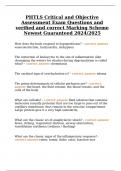PHTLS Critical and Objective
Assessment Exam Questions and
verified and correct Marking Scheme
Newest Guaranteed 2024/2025
How does the body respond to hypoperfusion? - correct answer
vasoconstriction, tachycardia, tachypnea
The attraction of leukocytes to the site of inflammation (like
chumming the waters for sharks) during degranulation is called
what? - correct answer chemotaxis
The cardinal sign of overhydration is? - correct answer edema
The prime determinants of cellular perfusion are? - correct
answer the heart, the fluid volume, the blood vessels, and the
cells of the body
What are colloids? - correct answer fluid solution that contains
molecules (usually proteins) that are too large to pass out of the
capillary membrane, thus remain in the vascular compartment.
Large protein give it a very high osmolarity.
What are the classic s/s of anaphylactic shock? - correct answer
hives, itching, respiratory distress, airway obstruction,
vasodilation erythema (redness / flushing)
What are the classic signs of the inflammatory response? -
correct answer rubor, tumor, dolor, calor, function loss
,What are the three primary phtls categories of shock? - correct
answer cardiogenic, distributive, hypovolemic
What is an io? - correct answer the technique of administering
fluids, blood and blood products, and medications into the
intraosseous space of a long bone
What is apoptosis? - correct answer normal, genetically
programed cell death
What is blood tubing? - correct answer macrodrip
administration set with duel piercing spikes
What is left ventricular hypertrophy? - correct answer increase
in the size of the cells increasing the size of the left ventricle
What is normal saline? - correct answer isotonic, 0.9% sodium
chloride
What is the most common cause of shock in the trauma patient? -
correct answer blood loss/ hypovolemia
What is used prehospital isotonic, hypertonic or hypotonic? -
correct answer isotonic
When oxygen does not reach the cell, what happens to the cell? -
correct answer hypoxia
,Internal blood loss: rib, radius or ulna, humerus, tibia or fubula,
femur, pelvis - correct answer rib: 125, radius or ulna: 250-500,
humerus: 500-750, tibia or fubula: 500-1000, femur: 1000-2000,
pelvis: 1000-massive
Osteomyelitis - correct answer in an open fracture, a bone
punctures the skin and the end can be contaminated with
bacteria from the skin or environment.
Contraindications to use of traction splint - correct answer -
suspected pelvic fracture
-suspected femoral neck (hip) fracture
-avulsion or amputation of the ankle and foot
-suspected fractures adjacent to the knee
Rami fracture - correct answer isolated fracture of the inferior
or superior rami which are generally minor and do not require
surgical stabilization.
Acetabular fracture - correct answer these fractures occur
when the head of the femur is driven into the acetabulum of the
pelvis.
Pelvic ring fractures - correct answer fractures of the pelvic
ring are typically classified into three categories. Life-
threatening hemorrhage is probably most common with vertical
shear fractures, but it may be associated with each type of pelvic
ring fracture.
3 categories of pelvic ring fractures:
1. Lateral compression fractures
, 2. Anterior-posterior compression fractures
3. Vertical shear fractures - correct answer 1. Lateral
compression fractures- occur when forces are applied to the
lateral aspects.
2. Anterior-posterior compression fractures- occur when forces
are applied in an anterior or posterior direction.
3. Vertical shear fractures- (worst of all) occur when a vertical
force is applied to the hemi-pelvis. Blood vessels are often torn
resulting in severe hemorrhage.
How do you splint dislocations? - correct answer splint
dislocations in "position found." however, when pulse is absent or
weak, gentle manipulation of the joint can be done to try to
return blood flow.
Life takes precedence over limb - correct answer when faced
with a critically injured trauma pt with extremity injuries that are
not bleeding, the focus should be on maintaing vital functions
through resuscitation, and only limited measures should be taken
to address the extremity injuries.
Analgesics should not be administered when... - correct answer
1. The pt presents with or develops signs and symptoms of shock.
2. Pain is significantly relieved with stabilization and splinting.
3. The pt appears under the influence of drugs or alcohol.
Morphine - correct answer -for use in pts with moderate to
severe pain.
-dosage should be titrated to the pt's response to pain and
physiological status.
-can be given iv, im, sq




